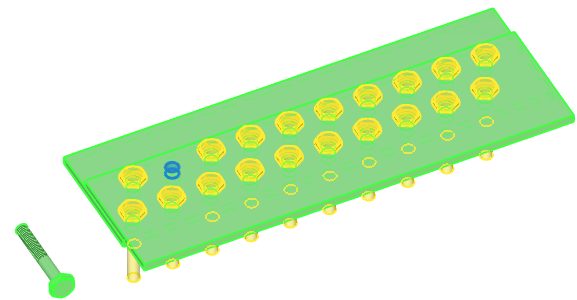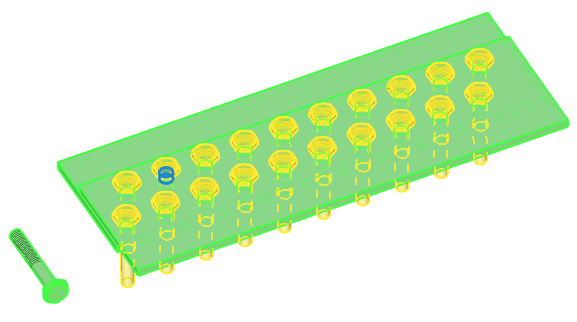Array of 3D Elements by Pattern |
  
|
Icon |
Ribbon |
|---|---|
|
3D Model > Operations > Array > Array by Pattern Assembly (3D) > Assembly > Array > Array by Pattern Sheet Metal (3D) > Advanced > Array > Array by Pattern Surfaces > Advanced > Array > Array by Pattern Primitives > Advanced > Array > Array by Pattern Support Geometry > Copy > Array > Array by Pattern |
Keyboard |
Textual Menu |
<3AC> |
Operation > Array > Array by Pattern |
The command creates an array, using another array of any type and class as a pattern. ![]() Hole operations can also be used as patterns.
Hole operations can also be used as patterns.
In order to create an array by pattern, perform following steps upon calling the command:
1.Choose a type of the array to be created (![]() array of constructions,
array of constructions, ![]() array of operations,
array of operations, ![]() array of bodies,
array of bodies, ![]() array of faces,
array of faces, ![]() array of fragments);
array of fragments);
2.Select source objects of the array;
3.Select a pattern (an array or a face of a hole);
4.Select a source LCS (optional step, available upon selecting a hole as a pattern);
5.Include a source operation into the array (optional step)
6.Define optional parameters of the array (optional step);
7.Confirm the operation (![]() in the automenu or in the header of the parameters window).
in the automenu or in the header of the parameters window).
|
|
Command's parameters window |
Command's parameters window |
In order to select a pattern you need to activate![]() the Pattern input box in the General Parameters tab of the command's parameters window. It activates filters for selecting
the Pattern input box in the General Parameters tab of the command's parameters window. It activates filters for selecting ![]() faces and
faces and ![]() operations on the filter toolbar, so you can select
operations on the filter toolbar, so you can select ![]() the desired object in the 3D scene or in the model tree. However, the only operations available for selection are arrays of any type and class, while the only faces available for selection are faces created either by the
the desired object in the 3D scene or in the model tree. However, the only operations available for selection are arrays of any type and class, while the only faces available for selection are faces created either by the ![]() Hole operation, or by
Hole operation, or by ![]() arrays of faces whose source objects are faces of holes. An icon representing a type of a selected element, its name and name of its parent operation (in case of selecting a face) are displayed in the Pattern input box. You can
arrays of faces whose source objects are faces of holes. An icon representing a type of a selected element, its name and name of its parent operation (in case of selecting a face) are displayed in the Pattern input box. You can ![]() Clear the selection, using the button located in the right side of the input box. Despite having a name of a certain face displayed in the Pattern input box upon selecting a face of a hole, actually all holes created by the same operation are used as a pattern.
Clear the selection, using the button located in the right side of the input box. Despite having a name of a certain face displayed in the Pattern input box upon selecting a face of a hole, actually all holes created by the same operation are used as a pattern.
Upon selecting a pattern hole the Source LCS input box appears in the General Parameters tab of the command's parameters window. Activating ![]() this input box enables filters for selecting
this input box enables filters for selecting ![]() LCSes on the filter toolbar, so you can select
LCSes on the filter toolbar, so you can select ![]() , the desired object in the 3D scene or in the model tree. An icon representing a type of a selected LCS and its name are displayed in the Source LCS input box. You can
, the desired object in the 3D scene or in the model tree. An icon representing a type of a selected LCS and its name are displayed in the Source LCS input box. You can ![]() Clear the selection, using the button located in the right side of the input box.
Clear the selection, using the button located in the right side of the input box.
When using a hole as a pattern, copies in array are created by positioning a source object in the following way:
•When creating an ![]() array of fragments without selecting a source LCS, a global CS of a fragment is coincided with an LCS of a hole.
array of fragments without selecting a source LCS, a global CS of a fragment is coincided with an LCS of a hole.
•When creating other types of arrays without selecting a source LCS, either an LCS of a source object (if such LCS exists), or the global LCS of the current document is coincided with an LCS of a hole.
•When creating an array of any type with selecting a source LCS, selected LCS is coincided with an LCS of a hole.
Detailed information on coordinate systems of holes can be found in the Hole Orientation section.
Depending on a type of a pattern hole, the particular instance of a hole, which created the faces selected in the Pattern input box can be handled by in different ways. In some cases a copy of a source object based on this instance is created by default, in other cases creating such copy requires enabling the Include Source Operation checkbox in the command's parameters window.
Green bolt - source object of array
Yellow bolts - dynamic preview of operation result
Pattern face is highlighted in blue

The Include Source Operation checkbox is disabled

The Include Source Operation checkbox is enabled
Dynamic preview may ignore the result of enabling/disabling checkboxes until applying the Preview of Operation Result .
When creating array, using another array as pattern, position of new array's source object doesn't change. Thus, if position of new array's source object doesn't coincide with position of pattern array's source object, then positions of copies do not coincide as well.
When using non-parametric array as pattern, positions of copies in relation to source object in new array are same as positions of copies in relation to source object in pattern array.
When using parametric array (created either by the ![]() Parametric Array command, or by the
Parametric Array command, or by the ![]() Array by Table command with the Parametric Array option enabled) as pattern, new array inherits only a number of copies, while all other parameters are ignored. Thus, all copies of resulting array are located in the same point and have the same geometry, regardless of variables assigned to parameters of the source object. Therefore, using parametric arrays as patterns is impractical.
Array by Table command with the Parametric Array option enabled) as pattern, new array inherits only a number of copies, while all other parameters are ignored. Thus, all copies of resulting array are located in the same point and have the same geometry, regardless of variables assigned to parameters of the source object. Therefore, using parametric arrays as patterns is impractical.
Array by pattern inherits exclusion and limitations from pattern array. However, the result of applying limitations to array by pattern may differ from the result of applying limitations to pattern array due to different positions of arrays' source elements in relation to limiting elements. Limitations and exclusions inherited from pattern are not displayed in array by pattern command's parameters window.
The Dynamic preview ignores limitations. Use the Preview of Operation Result instead.
|
|
Pattern array before applying limitations; Limiting faces is outlined in red; 1 - Source object of pattern array. |
Pattern array after applying limitations. |
|
|
Pattern array is highlighted in blue; Dynamic preview of array by pattern |
Actual result of array by pattern |
See Also:
•Types of Arrays of 3D Elements
•Classes of Arrays of 3D Elements
•Limitations and Exclusions in Arrays of 3D Elements
•Referencing 3D Elements of Array